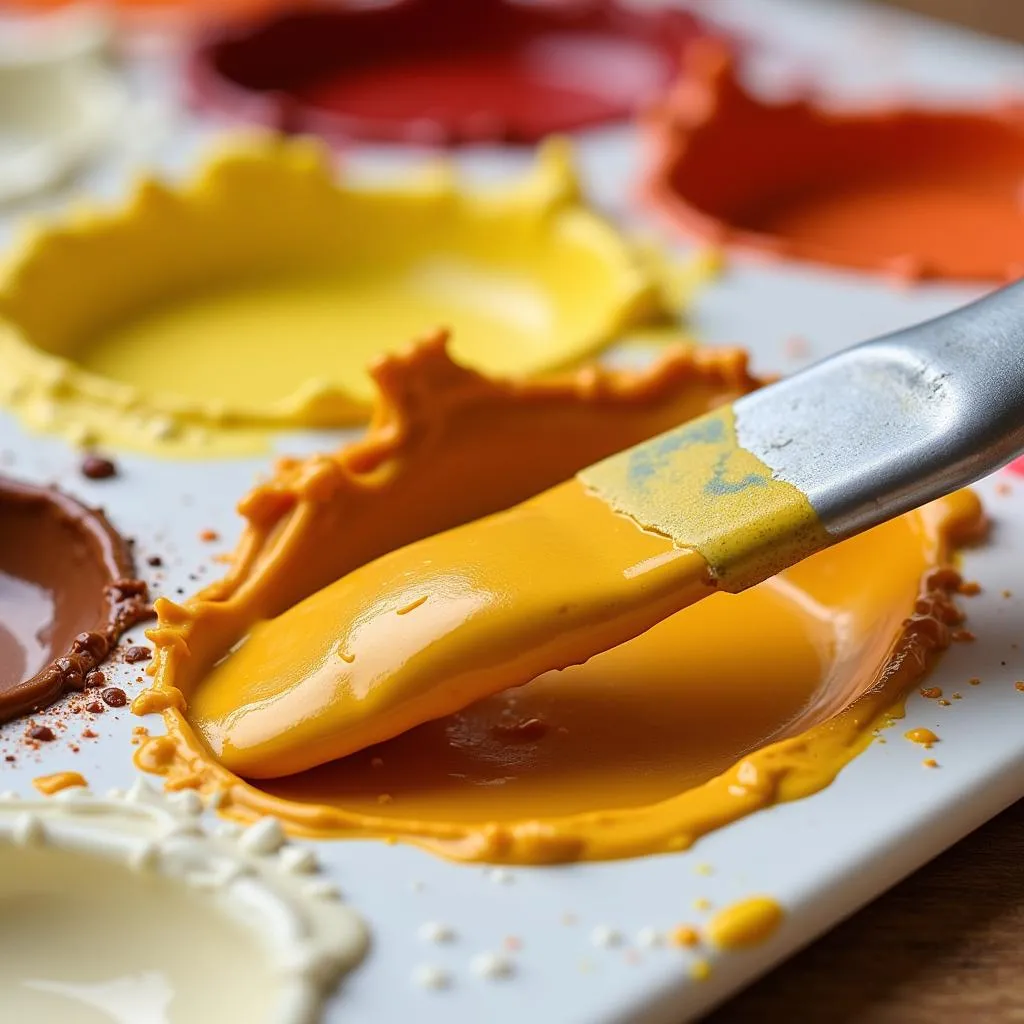Ever wondered how to create the luxurious hue of gold in your art projects or DIY endeavors? While you can’t actually mix primary colors to create real gold (it’s a precious metal, after all!), you can achieve a stunning gold effect by understanding color theory and using the right pigments. Let’s dive into the world of color mixing and explore the different ways to achieve that captivating gold!
Mixing Acrylics and Oils for a Golden Glow
In the realm of painting, getting that perfect gold often involves a bit of a workaround. You won’t find a “pure gold” tube on the shelves! Instead, you’ll be using a combination of colors to create the illusion of gold.
Here are a few techniques using common acrylic and oil paints:
-
Yellow and Brown: Starting with a strong yellow base, gradually incorporate small amounts of brown. Experiment with different browns, like burnt umber or raw sienna, to adjust the warmth and depth of your gold.
-
Yellow and Red: A touch of red added to yellow can create a warmer, more antique gold. Cadmium yellow light mixed with a tiny amount of alizarin crimson can yield beautiful results.
-
Metallic Additives: To enhance the metallic shimmer of your mixed gold, consider adding a metallic medium or paint. Gold interference paints, which reflect light in a sparkling manner, can add a magical touch.
 Mixing gold paint on a palette
Mixing gold paint on a palette
Watercolor Gold: A Transparent Approach
Achieving gold with watercolors requires a slightly different technique, focusing on layering and transparency:
-
Layering Yellows: Start with a light yellow wash, allowing it to dry completely. Gradually build up the intensity by adding layers of darker yellows, like raw sienna or yellow ochre.
-
Adding Depth with Brown: A light wash of burnt umber or sepia can add depth and richness to your watercolor gold. Be mindful of the water-to-paint ratio to maintain transparency.
-
Metallic Watercolors: Some brands offer metallic watercolors in gold and other shimmering hues. These can add a beautiful, luminous effect to your artwork.
Beyond Painting: Exploring Gold in Other Mediums
The quest for gold isn’t limited to canvases! Here’s how you can incorporate a touch of gold in other creative mediums:
-
Coloring Buttercream: For a gilded cake decorating experience, experiment with gel food coloring. Start with a tiny amount of brown or orange gel color and gradually incorporate it into your white buttercream until you achieve the desired shade of gold.
-
Digital Design: In the digital world, achieving gold is as simple as selecting the right hexadecimal color code. Some popular choices include #FFD700 (golden yellow) and #DAA520 (goldenrod).
The Psychology of Gold: More Than Meets the Eye
Gold has always held a special place in human history and culture, symbolizing wealth, success, and prosperity. Its warm, radiant glow evokes feelings of optimism, luxury, and sophistication. Whether you’re creating art, decorating your home, or simply adding a touch of sparkle to your day, understanding the psychological impact of gold can enhance your creative choices.
Achieving Golden Perfection: Tips and Tricks
- Test Your Colors: Always test your gold mixtures on a scrap piece of paper or canvas before applying them to your final work.
- Lighting Matters: The way gold appears can change dramatically under different lighting conditions. Observe your gold under natural and artificial light to ensure it achieves the desired effect.
- Less is More: When working with gold, especially metallics, a little goes a long way. Start with small amounts and gradually build up the intensity to avoid an overwhelming or gaudy appearance.
Expert Insight from renowned color specialist, Anya Sharma:
“Gold is such a versatile color. It can be bold and dramatic or subtle and elegant. The key is to experiment and find what works best for your personal style and the project at hand.”
Frequently Asked Questions about Mixing Gold
1. Can I mix blue and yellow to make gold?
While blue and yellow are primary colors, mixing them will create green, not gold. To achieve gold, focus on combinations of yellow, red, and brown.
2. What’s the best way to make gold paint for walls?
Instead of mixing your own, it’s best to purchase pre-mixed gold paint for walls. This ensures a consistent color and finish. Many paint brands offer a wide range of gold hues, from light and shimmery to deep and antique.
3. What color complements gold well?
Gold pairs beautifully with a variety of colors. For a classic look, try navy blue, emerald green, or deep red. For a more modern feel, experiment with teal, blush pink, or even black.
 Gold accents in a modern living room
Gold accents in a modern living room
4. Can I use gold leaf to create a gold effect?
Yes, gold leaf is a thin sheet of real gold that can be applied to various surfaces for a luxurious, gilded finish. It requires some practice and special adhesive, but the results can be stunning.
5. How can I make my gold paint more vibrant?
Adding a touch of white paint to your gold mixture can actually make it appear brighter and more vibrant by increasing its opacity.
Need More Color Inspiration?
Check out these other informative articles on our website:
Whether you’re a professional artist or a DIY enthusiast, understanding the nuances of color mixing opens up a world of creative possibilities. So go forth and create your own golden masterpieces!
Need help finding the perfect shade of gold? Contact us! Our expert team at Color Box Hanoi is here to assist you. Call us at 0373298888, email us at [email protected], or visit our showroom at 86 Cầu Giấy, Hà Nội. We offer 24/7 customer support and are always happy to help you bring your color visions to life.

